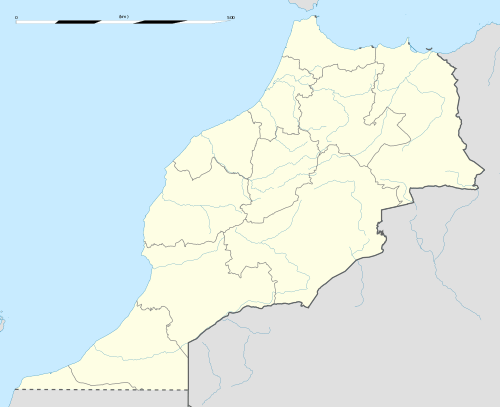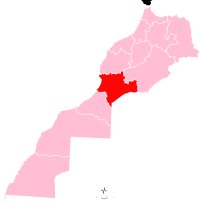Tiznit
Tiznit or Tiznet (Arabic: تزنيت, romanized: Tiznīt; Berber languages: ⵜⵉⵣⵏⵉⵜ, romanized: Tiznit) is a town in the southern Moroccan region of Souss-Massa, founded in 1881 by the sultan Hassan I. It is the capital of Tiznit Province and recorded a population of 74,699 in the 2014 Moroccan census.[1] Jewish silversmiths moved into the town and established its reputation as the center of silver and silver handicraft in Morocco. Tiznit is well known for its silver jewelry, mint, daggers and sabres.
Tiznit Tiznet | |
|---|---|
 .jpg) .jpg)  | |
 Tiznit Location in Morocco | |
| Coordinates: 29°43′N 9°43′W | |
| Country | |
| Region | Souss-Massa |
| Province | Tiznit |
| Population (2014)[1] | |
| • Total | 74,699 |
| Time zone | UTC+0 (WET) |
| • Summer (DST) | UTC+1 (WEST) |
Located near the coast, Sultan Moulay Hassan settled in the area in 1881 to exert his control over dissident Berber tribes of the Souss. In 1912, Ahmed al-Hiba (El Hib), a populist rebel overthrew the French government and proclaimed himself sultan of Tiznit in the town's mosque.[2] He conquered the Sous by uniting the tribes of the Anti Atlas Mountains. He went on to attack Marrakech but was suppressed by the French.
The province of Tiznit is in the western side of the Anti-Atlas. Tiznit, some 80 km south of Agadir, is a strategic crossroads between the mountainous Tafraoute region, the Atlantic coast and the great Moroccan Sahara.
Historically speaking, Tiznit was the starting point of the famous dynasty of Almoravides who came to rule Morocco from Madrasa El Ouaggaguia in Aglou (a coastal village 14 km from Tiznit). The history of the city is also linked to the particular importance the Alawite Sultans granted to the city. Sultan Moulay Hassan I visited Tiznit twice, the first time in 1882 and the second time in 1886.
Among the monuments that characterize the city of Tiznit are Khalifa Palace, El Méchouar Place and the Grand Mosque. The old Medina of Tiznit is enclosed by a wall of five historic gates: Bab Aglou, Bab el Khemis, Bab Targa, Bab el Maader and Bab Oulad Jerrar. All of these gates are of Alawite tradition and strongly resemble those of the city of Essaouira.
Tiznit is the place of manufacture of the finest jewels of the South of Morocco. There are daggers, horse saddles, Fantasia rifles, anklets, pendants that women attach to their chests or foreheads all decorated with semi-precious stones and enamels.
What distinguishes the city of Tiznit is its dynamic civil society. There are more than 200 associations working in a number of areas, particularly development, education, culture, philanthropy, sport, and music; a fact which makes the city the center of a remarkable cultural radiation in the south of Morocco.
Also, Tiznit has a number of public facilities; there are five socio-cultural centers in the city, Mokhtar Soussi Multimedia Library, 10 sport fields for proximity, Almassira Stadium with good grass, Olympic Swimming Pool, Cinema Hall Bahia, road station, Museum of Heritage, Handicraft Complex, 4 rated hotels etc.
The city council of Tiznit is highly hailed by people for the efforts it invests to keep the city a tourist attraction.
International relations
Twin towns – Sister cities
Tiznit is twinned with:


In popular culture
- British blues rock singer Ramon Goose used Tiznit as his subject matter for the song "Long Road to Tiznit" from the album also called Long Road to Tiznit (World Music Network) inspired by his travels in the region.
- Swedish gothic metal band Tiamat has an instrumental track named "Tiznit" on their 2012 album The Scarred People.
References
- "POPULATION LÉGALE DES RÉGIONS, PROVINCES, PRÉFECTURES, MUNICIPALITÉS, ARRONDISSEMENTS ET COMMUNES DU ROYAUME D'APRÈS LES RÉSULTATS DU RGPH 2014" (in Arabic and French). High Commission for Planning, Morocco. 8 April 2015. Retrieved 29 September 2017.
- Morocco. Dorling Kindersley Eyewitness Travel Guides. 2006.
External links
| Wikivoyage has a travel guide for Tiznit. |
- English version of Le Portail de la ville de Tiznit
- Tiznit entry in the Encyclopedia of the Orient
- Le Portail des berbères marocains
- Entry in Lexicorient
